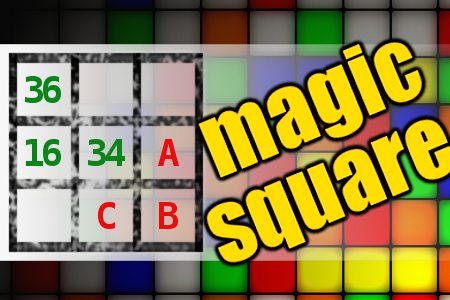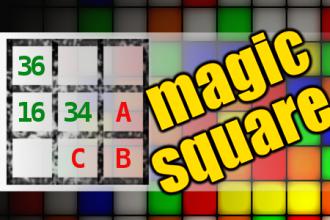MAGIC SQUARE: Calculate A+B*C
The aim is to place the some numbers from the list (9, 12, 16, 22, 25, 31, 33, 34, 36, 38, 40, 42, 59) into the empty squares and squares marked with A, B an C. Sum of each row and column should be equal. All the numbers of the magic square must be different. Find values for A, B, and C. Solution is A+B*C.Correct answers: 9
The first user who solved this task is Nasrin 24 T.
#brainteasers #math #magicsquare

A famous sexologist was giving...
A famous sexologist was giving a lecture in front of a big crowd.
"There are 4 kinds of men when it comes to sex. The first kind does it every day. You can usually recognize him by his masculine body and the constant smile on his face. Do we have anyone like this in the audience?"
A man got up from the audience and he fitted the description: Big firm body with a smile on his face.
"Then there is the second kind. They have sex once a week. They also have a generally happy mood, and look pretty good, but of course not as good as the first kind. Is there any one of them here tonight?".
A second man got up, and he too fitted the description.
"The third kind do it once a month. They are chubby and usually grumpy. Anyone of them here?".
The man that raised from his chair looked exactly like the expert claimed.
"And then there is the 4th kind. They do it once a year. They usually have a big belly, but the thing that is most tipical is that they are in a constant state of depression. I know it would be hard for him to admit, but if there is one of those in the audience, please rise".
A fat and short man stood up, but in contrary to the experts prediction, he looked very cheerful.
"You do it only once a year?" the expert asked.
"Yes, only once a year."
"So why are you so happy?" demanded the expert.
"Well", said the man, cheeringly, "Tonight is the night!"
"There are 4 kinds of men when it comes to sex. The first kind does it every day. You can usually recognize him by his masculine body and the constant smile on his face. Do we have anyone like this in the audience?"
A man got up from the audience and he fitted the description: Big firm body with a smile on his face.
"Then there is the second kind. They have sex once a week. They also have a generally happy mood, and look pretty good, but of course not as good as the first kind. Is there any one of them here tonight?".
A second man got up, and he too fitted the description.
"The third kind do it once a month. They are chubby and usually grumpy. Anyone of them here?".
The man that raised from his chair looked exactly like the expert claimed.
"And then there is the 4th kind. They do it once a year. They usually have a big belly, but the thing that is most tipical is that they are in a constant state of depression. I know it would be hard for him to admit, but if there is one of those in the audience, please rise".
A fat and short man stood up, but in contrary to the experts prediction, he looked very cheerful.
"You do it only once a year?" the expert asked.
"Yes, only once a year."
"So why are you so happy?" demanded the expert.
"Well", said the man, cheeringly, "Tonight is the night!"

